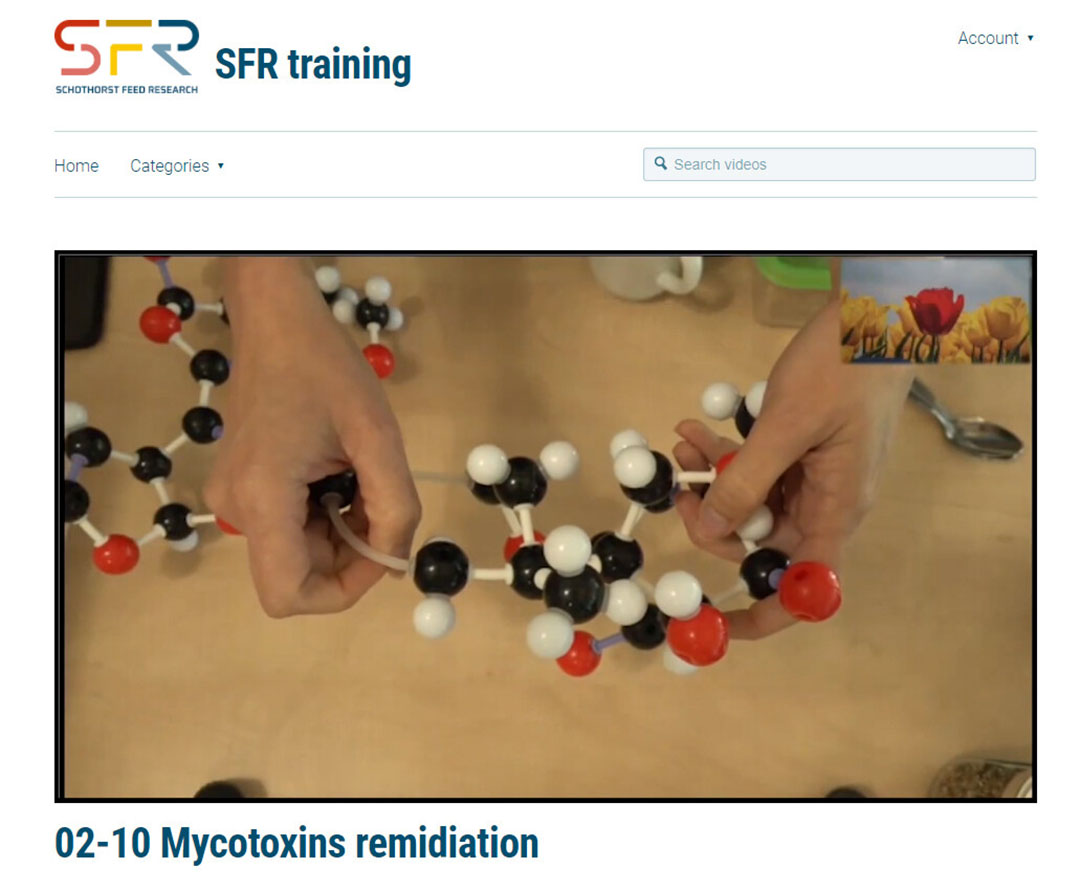Feed training teaches all about mycotoxins

For the 10th time, Schothorst Feed Research has organised a Feeds and Nutrition course. For the first time the training was held online. All About Feed participated in the mycotoxin module of the course.
The Feeds and Nutrition course of Schothorst Feed Research is an annually recurring training programme in which participants are informed on the main theoretical and practical aspects of feed production. This year, the feed course was organised in June and it consisted of 11 different modules. The first week’s modules provided in-depth information on feedstuffs and mycotoxins. In the following weeks there were courses on the various animal species. Due to Covid-19 restrictions this was the first year the training was offered online. All About Feed had the opportunity to participate in one of the modules which focused on mycotoxins. This training was led by Regiane Santos, researcher at Schothorst Feed Research.

Insects make holes in the plants, which stimulates the growth of mould and thus mycotoxins. If we stop using pesticides, which is socially desirable, we can expect a lot more mycotoxins.
Climate change and effect on mycotoxins
During a 2-day course, Regiane Santos covered everything on mycotoxins, starting with the basics. She informed the participants about which mycotoxins are especially important in livestock and in which feedstuffs which type of mycotoxins can be found. The training then went further in depth with information on how climate change is affecting the occurrence of mycotoxins. A combination of higher temperatures, CO2 and plant water activity leads to an increase in mycotoxin contamination of feed stuffs. Also, due to climate change, the incidence of insect pests will increase, Santos explained that this could lead to more mycotoxin contamination: “Insects make holes in the plants, which stimulates the growth of mould and thus mycotoxins. If we stop using pesticides, which is socially desirable, we can expect a lot more mycotoxins.” To adapt to the influences of climate change, Santos thinks we need to find a way to produce feed in a smart way. “We need technology for effective forecasting systems and real-time monitoring of mycotoxins.”
Regulation and sampling of feed
Next up were the topics, regulation and sampling. The only regulated mycotoxin in feed worldwide is Aflatoxin, while for the other feed-related toxins there are only recommended levels. These vary per continent or country. To ensure that the toxin level remains below these levels, samples are taken from the feed. The main problem of sampling is the fact that mycotoxins are heterogeneously distributed in the feed materials. Santos: “To reduce sample variability it is recommended to increase the sample size as well as the test portion size and reduce the grain size by grinding the grains.” Via a live video connection, the participants practised taking a feed sample in the right way, which shows that it is important to comply with the 3 conditions listed by the trainer. Besides feed sampling, it is possible to obtain biological samples from animals. However, this is only useful to demonstrate the efficacy of decontamination, explains Santos.
{{phot,3}}
Prevention and remediation
A key topic in a programme like this is preventing mycotoxin contamination. In the training provided by Schothorst Feed Research several prevention strategies are addressed: at the field level, during storage and transport, and when processing the feed.
Ploughing and crop rotation could be appropriate measures at the field level and during storage additives could help to reduce mycotoxin risks. Santos explains that before processing feed there are also actions that could be taken: “Mycotoxins are very stable over time, including during feed processing, so cleaning or sorting the feed ingredients before processing can be an efficient method.” However, contamination with mycotoxins seems to be unavoidable and therefore mycotoxin decontamination with adsorbing agents or binders for example could be necessary at the animal level, according to Santos. “It’s important to be very critical and ask for scientific evidence of the effectiveness of these additives; for instance, in vitro efficiency does not guarantee success in vivo.”
During this part of the course, it was discussed which additive to use for which type of mycotoxin. DON, for example, has no binding ability and it is only possible to break it down with enzymes, while ZEN and OTA can bind.
After a full day of information, the training closed off with a fun quiz. This showed that the participants had paid attention and the conclusion was that information had been presented clearly, since they were able to answer many of the questions.
Although pigs are the more sensitive than poultry to DON, this mycotoxin can also impair the performance of chickens.
Mycotoxin training day 2: Zoomed in on pigs and poultry
The 2nd day of the mycotoxin training zoomed in on the effects of mycotoxins on pigs and poultry. Regiane Santos started off with an important note: “The doses make the poison. The type of mycotoxin, the duration of any exposure and animals health all have an influence; however, it’s the dose that determines the toxicity.” She then continued with a detailed overview and explanation of the most important mycotoxins and how these affect pigs and poultry. “Although pigs are the more sensitive than poultry to DON, this mycotoxin can also impair the performance of chickens. DON is called the vomitoxin, however only if present in high levels it can cause vomiting in pigs.” The in-depth overview provided by Santos gave the participants good insight into the problems mycotoxins cause for pigs and poultry. The online course ended with an explanation of various research studies and case studies, in which all the information learned was explained and applied once again.
This Feeds and Nutrition course is an annual event that covers the main aspects of feed production. Information about next year’s course can be found on the website of Schothorst Feed Research.











